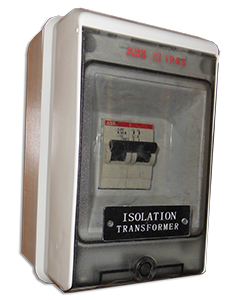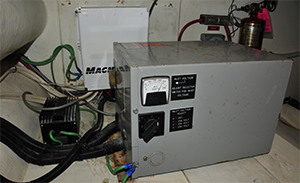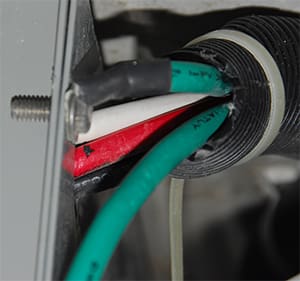Shoreside power transformers have been used aboard recreational, commercial and military vessels for decades. Lately the trend toward their use has increased, and with good reason. Transformers offer users a variety of safety and convenience advantages over standard shore power systems that lack this valuable component.
Isolation vs. polarization
It’s important to begin this discussion by noting that transformers can be wired in one of two configurations, either for isolation or polarization. In either case, a transformer’s greatest attribute is its ability to reduce the risk of shock, electrocution and electric shock drowning (ESD) — see sidebar for more on this. When wired in isolation mode, a transformer also acts as a deterrent against galvanic corrosion, which can result from interactions with surrounding vessels, steel bulkheads or other nearby submerged and grounded metallic objects. The principle upon which a shore power transformer works is simple; however, there are a number of peculiarities a potential user or installer must be aware of in order to ensure a safe, reliable and effective installation.
 |
|
This inverter installation includes non-metallic strain relief cord grips. |
In many ways, a transformer behaves much like a source of power, similar to a generator, inverter or the utility company transformer at the head of the dock for that matter. The most important safety-related aspect of this behavior involves the path electricity takes as it is “produced” by or leaves the transformer. Like all electricity, it seeks a return to its origin, and not necessarily ground. Electricity “returns” to ground only when the power source is referenced to ground; in the case of the transformer at the head of the dock, this is accomplished with a ground rod, which is bonded to the transformer’s neutral output. The importance of this feature cannot be overemphasized. Shore power electricity, once it passes through the vessel’s transformer, will only return to that transformer, either through the white neutral conductor or the green safety-grounding conductor (these two are typically bonded or connected either at the transformer output or at the electrical panel — not both — for transformer-equipped vessels only), whether by design or in the case of a fault. Electricity that originates at an onboard transformer will not, assuming an intact grounding/bonding system, travel through seawater to reach a utility company transformer at the head of the dock. It will instead return to the vessel’s onboard transformer, thereby protecting persons in the water.
How it works
The transformer is able to achieve this through the principal of inductance. In brief, shore power travels from the dock, through the shore power cable or cables (one onboard transformer is required for each shore power inlet that can be used simultaneously), and on to the boat’s shore power inlet. However, instead of going from there to the vessel’s circuit breaker panel, the isolation transformer is inserted into the circuit first. The incoming AC power travels through the primary or input winding of the transformer and back to shore. That’s as close as the dockside shore power ever gets to the boat’s electrical system. Electricity is electromagnetically induced on the transformer’s secondary, output or boatside winding; no direct connection is required between the two. This arrangement also eliminates the possibility of reverse polarity (it’s telling that vessels equipped with 120-volt onboard transformers are exempt from ABYC’s reverse polarity indicator requirement), while significantly reducing the possibility of electrocuting a person in the water. Regardless of this protection, under no circumstances should people swim around vessels or docks that are plugged in to shore power — even where vessels are equipped with transformers.
 |
|
Overcurrent protection in the form of a double-pole circuit breaker is mandatory for transformer input and output wiring. |
There’s a price to be paid for the benefits offered by transformers. The average 30-amp unit may measure a little under a cubic foot and weigh 60 pounds, while a 50-amp, 240-volt unit can measure half again as large and well over 200 pounds. Additionally, transformers must be provided with appropriate ventilation, as they do generate heat, and will produce a noticeable hum (which means you wouldn’t want to place one under a berth). Ideally, shore power transformers should carry a marine UL listing (while most industrial transformers are UL Listed, few carry the “Marine Use” certification), as well as full adherence to American Boat and Yacht Council (ABYC) standards.
Important distinctions
When wiring a transformer, the installer will have a choice of either isolation or polarization. The distinctions that exist between isolation transformers and polarization transformers are few, but they are important nonetheless.
The primary difference is in the means of grounding. The polarization transformer’s primary and secondary ground are connected — in other words, the vessel’s AC safety ground is common with the dock/shore AC safety ground and therefore no galvanic isolation, the type required to prevent corrosion induced from other nearby vessels, is afforded. Thus, polarization transformer installations must also include another device known as a galvanic isolator in order to deter corrosion.
 |
|
A transformer with manual input, enabling it to boost incoming voltage. |
Conversely, potentially damaging galvanic current, which normally would be allowed to come aboard via the green grounding conductor in the shore power cable, is thwarted by the isolation transformer because there is no longer any direct connection to shoreside ground or current-carrying conductors. The transformer’s secondary is, in effect, the source of power and thus the ground reference.
It is virtually impossible to determine whether a transformer is wired in polarization or isolation mode by casual visual inspection. The identical ABYC-compliant transformer may be wired either way in full compliance with ABYC and manufacturer guidelines during installation. Only with a careful inspection of the actual wiring connections and/or the use of a multi-meter can this be determined for certain.
The distinction between polarization and isolation also represents a marked difference between the isolation transformer and the galvanic isolator. Where the galvanic isolator attempts to block DC voltage (nearly all galvanic corrosion is DC in nature) from coming aboard up to a given threshold of about 1.4 volts, the isolation transformer severs this connection altogether with no limitation. It’s as thorough an electrical separation as can be achieved under these circumstances.
 |
|
For vessels equipped with twin shore power inlets that can be used simultaneously, a separate transformer is needed for each. |
The onboard AC green safety-grounding conductor originates at the secondary winding of the isolation transformer. As a result, primary and secondary ground — the shoreside ground and the boat’s ground — have nothing in common, which eliminates the potential for “foreign” (originating off the boat) galvanic and stray current corrosion. Stray and galvanic current corrosion that originates aboard your own boat remains potentially destructive and not prevented or reduced by the isolation transformer, galvanic isolator or any other device except a proper bonding system and general ABYC-compliant wiring procedures.
With the installation of the isolation transformer, all onboard bonding, DC grounds and AC safety grounds remain unchanged. Additionally, because the transformer’s enclosure cannot be connected to both primary and secondary grounds, as doing so would eliminate its isolation and corrosion effectiveness, absolute attention to detail must be observed when installing AC wiring through the transformer’s steel case. A failure to do so could result in the case becoming energized, thereby presenting an electrocution hazard. Properly configured, proprietary and preferably non-metallic strain relief fittings must be used in order to eliminate the possibility of chafe or contact between an energized conductor and the unit’s metal housing.
In accordance with ABYC recommendations, primary input cabling must also be equipped with overcurrent protection. Equipment leakage circuit interrupters (ELCI) — circuit breakers that embody ground fault protection — are an amalgamation of a circuit breaker and a GFCI receptacle. ELCIs offer ground-fault and overcurrent protection to the transformer’s primary circuit installation, albeit it with a significantly higher trip threshold of 30 mA compared to the 5-mA threshold of a GFCI. This device also serves to prevent electrocution and ESD in the event of a ground fault between the transformer and the shore inlet.
Polarization transformers, on the other hand, maintain the shoreside ground connection. While polarization transformers ensure correct onboard polarity in the event of a dockside fault, in addition to reducing the likelihood of electrocution and ESD, they will do little — if anything — to prevent corrosion because the shoreside ground remains intact.
 |
|
Connections can be wired various ways. This installation uses terminal strips, ensuring reliability. |
Advocates for their use point out that polarization transformers are safer than isolation transformers because their metal enclosures are connected to shore as well as the vessel’s grounding system, making an unresolved ground fault to the case nearly impossible. When used with a galvanic isolator, they too provide a measure of shore-induced corrosion protection (up to 1.4 volts of blocking voltage vs. the infinite blocking ability of the isolation transformer).
An isolation transformer may, at the discretion of the installer or vessel owner, be installed in either the isolation or polarization mode, depending entirely upon the ground connection method. In either case, the installation must meet current ABYC guidelines and manufacturer-recommended installation schematics, of which there are several options.
Boosting option
Standard shore power transformers offer what’s known as a 1:1 power ratio. That is, the output is identical to the input. Optionally, transformers may be designed for boosting capability, either manual or automatic. In this configuration, low dockside voltage can be boosted, to a degree, reducing the detrimental effects to which it can lead, particularly for motors and refrigeration and air conditioning compressors. So, 208 volts (or less), a standardized voltage encountered on many docks, particularly in older marinas, could be boosted to 220 or more volts.
 |
|
When wired as a polarization transformer, there is no galvanic corrosion protection. Here, two galvanic isolators are used. |
Common 240-volt, 50-amp transformers are typically wired for a 240-volt input or primary alone, from which they provide “split phase” distribution — 120/240 volts from the secondary. For 1:1 non-boosting transformers, this can present a problem: If the primary voltage is 208 volts (and often less), the split-phase output voltage will be 208/104 volts, which is below the voltage specified by most equipment manufacturers — particularly, again, motors and compressors. Conversely, a non-transformer equipped split-phase circuit will yield 208/120 volts. Therefore, in some cases, a 1:1 transformer may in fact lead to low-voltage-related equipment malfunctions and failures.
A limited number of isolation transformer manufacturers produce units appropriate for the recreational cruising or commercial vessel (and still fewer produce units that are compliant with UL Marine standards). Whichever product you may use, it should ideally be ABYC compliant, and the installation instructions must be followed to the letter. Otherwise, the expense and benefits, as well as safety, of the isolation transformer may be negated. AC shore power wiring, unless you are trained and experienced, should be left to the pros, preferably an ABYC-certified marine electrician.
Steve D’Antonio owns and operates Steve D’Antonio Marine Consulting, Inc. (stevedmarineconsulting.com), providing consulting services to boat buyers, owners and the marine industry. He is an ABYC-Certified Master Technician.

